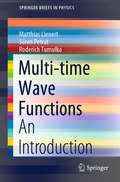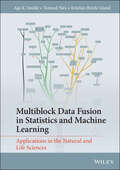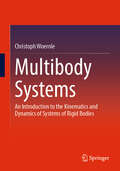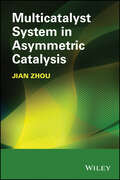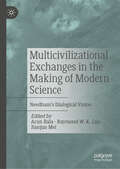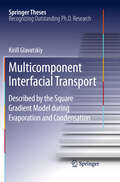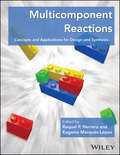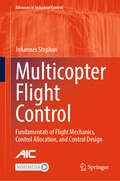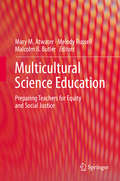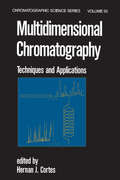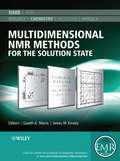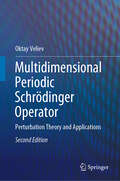- Table View
- List View
Multi-time Wave Functions: An Introduction (SpringerBriefs in Physics)
by Matthias Lienert Sören Petrat Roderich TumulkaThe natural generalization of the quantum-mechanical N-particle wave function to relativistic space-time is a function of N space-time points, and thus of N time variables. This book, based on a collection of lectures given at a spring school in Tübingen in 2019, provides an accessible and concise introduction to the recent development of the theory of multi-time wave functions, their use in quantum field theory, their relation to detection probabilities, and the mathematical question of consistency of their time evolution equations. The book is intended for advanced students and researchers with an interest in relativity and quantum physics.
Multiblock Data Fusion in Statistics and Machine Learning: Applications in the Natural and Life Sciences
by Tormod Næs Age K. Smilde Kristian Hovde LilandMultiblock Data Fusion in Statistics and Machine Learning Explore the advantages and shortcomings of various forms of multiblock analysis, and the relationships between them, with this expert guide Arising out of fusion problems that exist in a variety of fields in the natural and life sciences, the methods available to fuse multiple data sets have expanded dramatically in recent years. Older methods, rooted in psychometrics and chemometrics, also exist. Multiblock Data Fusion in Statistics and Machine Learning: Applications in the Natural and Life Sciences is a detailed overview of all relevant multiblock data analysis methods for fusing multiple data sets. It focuses on methods based on components and latent variables, including both well-known and lesser-known methods with potential applications in different types of problems. Many of the included methods are illustrated by practical examples and are accompanied by a freely available R-package. The distinguished authors have created an accessible and useful guide to help readers fuse data, develop new data fusion models, discover how the involved algorithms and models work, and understand the advantages and shortcomings of various approaches. This book includes: A thorough introduction to the different options available for the fusion of multiple data sets, including methods originating in psychometrics and chemometrics Practical discussions of well-known and lesser-known methods with applications in a wide variety of data problems Included, functional R-code for the application of many of the discussed methods Perfect for graduate students studying data analysis in the context of the natural and life sciences, including bioinformatics, sensometrics, and chemometrics, Multiblock Data Fusion in Statistics and Machine Learning: Applications in the Natural and Life Sciences is also an indispensable resource for developers and users of the results of multiblock methods.
Multibody Dynamics
by Josep M. Font-LlagunesThis book includes selected papers from the ECCOMAS Thematic Conference on Multibody Dynamics, that took place in Barcelona, Spain, from June 29 to July 2, 2015. By having its origin in analytical and continuum mechanics, as well as in computer science and applied mathematics, multibody dynamics provides a basis for analysis and virtual prototyping of innovative applications in many fields of contemporary engineering. With the utilization of computational models and algorithms that classically belonged to different fields of applied science, multibody dynamics delivers reliable simulation platforms for diverse highly-developed industrial products such as vehicle and railway systems, aeronautical and space vehicles, robotic manipulators, smart structures, biomechanical systems, and nanotechnologies.
Multibody Dynamics
by Zdravko TerzeBy having its origin in analytical and continuum mechanics, as well as in computer science and applied mathematics, multibody dynamics provides a basis for analysis and virtual prototyping of innovative applications in many fields of contemporary engineering. With the utilization of computational models and algorithms that classically belonged to different fields of applied science, multibody dynamics delivers reliable simulation platforms for diverse highly-developed industrial products such as vehicle and railway systems, aeronautical and space vehicles, robotic manipulators, smart structures, biomechanical applications and nano-technologies. The chapters of this volume are based on the revised and extended versions of the selected scientific papers from amongst 255 original contributions that have been accepted to be presented within the program of the distinguished international ECCOMAS conference. It reflects state-of-the-art in the advances of multibody dynamics, providing excellent insight in the recent scientific developments in this prominent field of computational mechanics and contemporary engineering.
Multibody Systems: An Introduction to the Kinematics and Dynamics of Systems of Rigid Bodies
by Christoph WoernleThe book Multibody Systems guides the reader from the fundamentals of engineering mechanics to the formulations of the kinematic and dynamic equations of systems of rigid bodies suitable for computational generation. Multibody systems are used for the numerical simulation of complex mechanical systems in mechanical engineering, automotive engineering, aerospace engineering, and biomechanics. The presentation focuses on the implicit and explicit mathematical formulations of the bonds that geometrically constrain the motion of the partial bodies and define the directions of the reaction forces and reaction moments. This results in a consistent and common approach to the various known forms of the equations of motion of multibody systems. In addition to open multibody systems with a tree structure, closed multibody systems with kinematic loops are also treated in detail. In the third edition, planar multibody systems are presented in a separate chapter to facilitate the transition from mass point systems to spatial multibody systems.
Multicatalyst System in Asymmetric Catalysis
by Jian ZhouThis book introduces multi-catalyst systems by describing their mechanism and advantages in asymmetric catalysis. * Helps organic chemists perform more efficient catalysis with step-by-step methods* Overviews new concepts and progress for greener and economic catalytic reactions* Covers topics of interest in asymmetric catalysis including bifunctional catalysis, cooperative catalysis, multimetallic catalysis, and novel tandem reactions* Has applications for pharmaceuticals, agrochemicals, materials, and flavour and fragrance
Multicellularity: Origins and Evolution
by John T. Bonner Karl J. Niklas Stuart A. NewmanThe evolution of multicellularity raises questions regarding genomic and developmental commonalities and discordances, selective advantages and disadvantages, physical determinants of development, and the origins of morphological novelties. It also represents a change in the definition of individuality, because a new organism emerges from interactions among single cells. This volume considers these and other questions, with contributions that explore the origins and consequences of the evolution of multicellularity, addressing a range of topics, organisms, and experimental protocols.Each section focuses on selected topics or particular lineages that present a significant insight or challenge. The contributors consider the fossil record of the paleontological circumstances in which animal multicellularity evolved; cooptation, recurrent patterns, modularity, and plausible pathways for multicellular evolution in plants; theoretical approaches to the amoebozoa and fungi (cellular slime molds having long provided a robust model system for exploring the evolution of multicellularity), plants, and animals; genomic toolkits of metazoan multicellularity; and philosophical aspects of the meaning of individuality in light of multicellular evolution. ContributorsMaja Adamska, Argyris Arnellos, Juan A. Arias, Eugenio Azpeitia, Mariana Benítez, Adriano Bonforti, John Tyler Bonner, Peter L. Conlin, A. Keith Dunker, Salva Duran-Nebreda, Ana E. Escalante, Valeria Hernández-Hernández, Kunihiko Kaneko, Andrew H. Knoll, Stephan G. König, Daniel J. G. Lahr, Ottoline Leyser, Alan C. Love, Raul Montañez, Emilio Mora van Cauwelaert, Alvaro Moreno, Vidyanand Nanjundiah, Aurora M. Nedelcu, Stuart A. Newman, Karl J. Niklas, William C. Ratcliff, Iñaki Ruiz-Trillo, Ricard Solé
Multicellularity: Origins and Evolution (Vienna Series in Theoretical Biology #18)
by Karl J. Niklas Stuart A. NewmanScholars consider the origins and consequences of the evolution of multicellularity, addressing a range of organisms, experimental protocols, theoretical concepts, and philosophical issues.The evolution of multicellularity raises questions regarding genomic and developmental commonalities and discordances, selective advantages and disadvantages, physical determinants of development, and the origins of morphological novelties. It also represents a change in the definition of individuality, because a new organism emerges from interactions among single cells. This volume considers these and other questions, with contributions that explore the origins and consequences of the evolution of multicellularity, addressing a range of topics, organisms, and experimental protocols.Each section focuses on selected topics or particular lineages that present a significant insight or challenge. The contributors consider the fossil record of the paleontological circumstances in which animal multicellularity evolved; cooptation, recurrent patterns, modularity, and plausible pathways for multicellular evolution in plants; theoretical approaches to the amoebozoa and fungi (cellular slime molds having long provided a robust model system for exploring the evolution of multicellularity), plants, and animals; genomic toolkits of metazoan multicellularity; and philosophical aspects of the meaning of individuality in light of multicellular evolution. ContributorsMaja Adamska, Argyris Arnellos, Juan A. Arias, Eugenio Azpeitia, Mariana Benítez, Adriano Bonforti, John Tyler Bonner, Peter L. Conlin, A. Keith Dunker, Salva Duran-Nebreda, Ana E. Escalante, Valeria Hernández-Hernández, Kunihiko Kaneko, Andrew H. Knoll, Stephan G. König, Daniel J. G. Lahr, Ottoline Leyser, Alan C. Love, Raul Montañez, Emilio Mora van Cauwelaert, Alvaro Moreno, Vidyanand Nanjundiah, Aurora M. Nedelcu, Stuart A. Newman, Karl J. Niklas, William C. Ratcliff, Iñaki Ruiz-Trillo, Ricard Solé
Multicivilizational Exchanges in the Making of Modern Science: Needham’s Dialogical Vision
by Arun Bala Raymond W. K. Lau Jianjun MeiThis book explores how and why exchanges across civilizations have come to enrich science today. The dialogical dimension of the history of science has long been marginalized by an excessive concern on why modern science emerged in Europe, but not in any of the advanced civilizations of the East. This focus upon what has been called Joseph Needham's "Grand Comparative Question" ignores his other project, focused on showing how dialogues between civilizations have nurtured science. Needham's "Grand Dialogical Question" – if we may call it that by parity – has directly or indirectly inspired a vast body of literature showing how interconnections of civilizations over the last three thousand years, and exchanges of cosmological, mathematical, geographical, physical, biological and medical technologies, techniques, practices and knowledge, have been woven together to produce current science. Bringing together scholars whose research range across multiple civilizations and disciplines, this book investigates the scope and limits of Needham's dialogical vision for science.
Multicomponent Interfacial Transport
by Kirill GlavatskiyA thermodynamically consistent description of the transport across interfaces in mixtures has for a long time been an open issue. This research clarifies that the interface between a liquid and a vapor in a mixture is in local equilibrium during evaporation and condensation. It implies that the thermodynamics developed for interfaces by Gibbs can be applied also away from equilibrium, which is typically the case in reality. A description of phase transitions is of great importance for the understanding of both natural and industrial processes. For example, it is relevant for the understanding of the increase of CO2 concentration in the atmosphere, or improvements of efficiency in distillation columns. This excellent work of luminescent scientific novelty has brought this area a significant step forward. The systematic documentation of the approach will facilitate further applications of the theoretical framework to important problems.
Multicomponent Reactions
by Raquel P. Herrera Eugenia Marqués-LópezAddressing a dynamic aspect of organic chemistry, this book describes synthetic strategies and applications for multicomponent reactions - including key routes for synthesizing complex molecules. * Illustrates the crucial role and the important utility of multicomponent reactions (MCRs) to organic syntheses * Compiles novel and efficient synthetic multicomponent procedures to give readers a complete picture of this class of organic reactions * Helps readers to design efficient and practical transformations using multicomponent reaction strategies * Describes reaction background, applications to synthesize complex molecules and drugs, and reaction mechanisms
Multicomponent Reactions in Organic Synthesis
by Qian Wang Jieping Zhu Meixiang WangComprehensive and up-to-date, this book focuses on the latest advances in the field, such as newly developed techniques, more environmentally benign processes, broadened scopes, and completely novel MCRs. In addition to carbene-promoted MCRs and frequently applied metal-catalyzed MCRs, it also covers recently developed catalytic enantioselective variants as well as MCR in drug discovery and for the synthesis of heterocyclic molecules and macrocycles. Edited by the leading experts and with a list of authors reading like a "who's who" in multicomponent reaction chemistry, this is definitely a must-have for every synthetic organic chemist as well as medicinal chemists working in academia and pharmaceutical companies.
Multicomponent Reactions: Synthesis of Bioactive Heterocycles
by K. L. Ameta Anshu DandiaThis timely book provides a succinct summary of methods for the synthesis of bioactive heterocycles using a multicomponent reaction (MCR) approach. The majority of pharmaceuticals and biologically active agrochemicals are heterocycles while countless additives and modifiers used in industrial applications are heterocyclic in nature. With the recent introduction of high-throughput biological evaluation, the importance of MCRs for drug discovery has been recognized and considerable efforts have been focused especially on the design and development of multi-component procedures for the generation of various bioactive heterocycles due to their significant therapeutic potential.
Multiconfigurational Quantum Chemistry
by Per-Olof Widmark Per Åke Malmqvist Roland Lindh Björn O. Roos Valera VeryazovThe first book to aid in the understanding of multiconfigurational quantum chemistry, Multiconfigurational Quantum Chemistry demystifies a subject that has historically been considered difficult to learn. Accessible to any reader with a background in quantum mechanics and quantum chemistry, the book contains illustrative examples showing how these methods can be used in various areas of chemistry, such as chemical reactions in ground and excited states, transition metal and other heavy element systems. The authors detail the drawbacks and limitations of DFT and coupled-cluster based methods and offer alternative, wavefunction-based methods more suitable for smaller molecules.
Multicopter Flight Control: Fundamentals of Flight Mechanics, Control Allocation, and Control Design (Advances in Industrial Control)
by Johannes StephanThis book presents a comprehensive discussion of the mechanical modelling and control of multicopters, more commonly referred to as drones. By selecting concepts for presentation based on their ease of comprehension and suitability for practical application, the author employs a straightforward and concise approach. A main objective is to examine both the theoretical and practical aspects, as well as their interrelationship. The book presents the fundamental functional algorithms of a multicopter flight control system, specifically: control allocation, or the distribution of a control demand among redundant actuators; low-level control loops to control rotational and vertical motion; simple guidance loops controlling the translational motion of a multicopter; and an introduction to Kalman filtering, which addresses the fusion of direct sensor measurement in order to estimate the state of the drone. These methods enable remotely piloted operation and preplanned path following. Multicopter Flight Control will be of particular interest to academic researchers and graduate students working in the field of aerospace engineering, as well as to practising engineers engaged in the development of drones and electric vertical take-off and landing aircraft. It provides a comprehensive and practical guide to the fundamentals of flight control and guidance techniques, offering valuable insights for those seeking to gain a deeper understanding of these topics. In order to derive the greatest benefit from reading this monograph, readers should possess a fundamental understanding of multiple-input, multiple-output system theory, particularly state-space representation, stability and feedback control. Additionally, a basic comprehension of rotor aerodynamics and rigid-body dynamics is essential.
Multicriteria Analysis and LCA Techniques
by Francesco Garbati Pegna Paolo Boncinelli Marco Vieri Daniele Sarri Enrico Cini Lucia RecchiaMulticriteria Analysis and LCA Techniques introduces the reader to the basic principles of multicriteria analysis (MCA) and life cycle assessment (LCA) techniques. The use of these tools is rapidly becoming essential in any feasibility study for comparing different solutions, selecting the most suitable ones, and for analyzing the interface of economy and environment. The main feature of Multicriteria Analysis and LCA Techniques is the application of a new approach to the analysis of energy balance and environmental impact of agro-industrial production chains. It gives detailed descriptions of a number of food and non-food agro-industrial applications of MCA and LCA, thereby providing the reader with practical examples of the implementation of these tools in the field of agro-industry. Multicriteria Analysis and LCA Techniques represents a subsidiary reference book for both undergraduate and graduate students, and can also be used for basic or applied academic research.
Multicultural Psychology
by Jeffery Scott Mio Lori A. Barker John Gonzalez Melanie M. Domenech RodríguezMulticultural Psychology combines quantitative and qualitative research with anecdotal material to examine an array of multicultural issues and capture the richness of diverse cultures. The text focuses on such compelling topics as differences in world views, communication, racial and cultural identity, development, racism, and immigration. Other issues covered in the text include gender, sexuality, age, and ability. The authors provide a strong, vivid, and personal voice to the text, richly populating it with anecdotes from themselves, their students, and other contributors and using these as central points around which to build their case for multicultural issues based on science.
Multicultural Science Education
by Malcolm B. Butler Mary M. Atwater Melody RussellThis book offers valuable guidance for science teacher educators looking for ways to facilitate preservice and inservice teachers'' pedagogy relative to teaching students from underrepresented and underserved populations in the science classroom. It also provides solutions that will better equip science teachers of underrepresented student populations with effective strategies that challenge the status quo, and foster classrooms environment that promotes equity and social justice for all of their science students. Multicultural Science Education illuminates historically persistent, yet unresolved issues in science teacher education from the perspectives of a remarkable group of science teacher educators and presents research that has been done to address these issues It centers on research findings on underserved and underrepresented groups of students and presents frameworks, perspectives, and paradigms that have implications for transforming science teacher education In addition, the chapters provide an analysis of the socio-cultural-political consequences in the ways in which science teacher education is theoretically conceptualized and operationalized in the United States. The book provides teacher educators with a framework for teaching through a lens of equity and social justice, one that may very well help teachers enhance the participation of students from traditionally underrepresented and underserved groups in science, technology, engineering, and mathematics (STEM) areas and help them realize their full potential in science. Moreover, science educators will find this book useful for professional development workshops and seminars for both novice and veteran science teachers. "Multicultural Science Education: Preparing Teachers for Equity and Social Justice directly addresses the essential role that science teacher education plays for the future of an informed and STEM knowledgeable citizenry. The editors and authors review the beginnings of multicultural science education, and then highlight findings from studies on issues of equity, underrepresentation, cultural relevancy, English language learning, and social justice. The most significant part of this book is the move to the policy level--providing specific recommendations for policy development, implementation, assessment and analysis, with calls to action for all science teacher educators, and very significantly, all middle and high school science teachers and prospective teachers. By emphasizing the important role that multicultural science education has played in providing the knowledge base and understanding of exemplary science education, Multicultural Science Education: Preparing Teachers for Equity and Social Justice gives the reader a scope and depth of the field, along with examples of strategies to use with middle and high school students. These classroom instructional strategies are based on sound science and research. Readers are shown the balance between research-based data driven models articulated with successful instructional design. Science teacher educators will find this volume of great value as they work with their pre-service and in-service teachers about how to address and infuse multicultural science education within their classrooms. For educators to be truly effective in their classrooms, they must examine every component of the learning and teaching process. Multicultural Science Education: Preparing Teachers for Equity and Social Justice provides not only the intellectual and research bases underlying multicultural studies in science education, but also the pragmatic side. All teachers and teacher educators can infuse these findings and recommendations into their classrooms in a dynamic way, and ultimately provide richer learning experiences for all students. " Patricia Simmons, North Carolina State University, Raleigh, USA "This provocative collection of chapters is a presentation in gutsiness Ingenious in construction and sequencing, this book will influence science teacher educators by introducing them to is...
Multidimensional Approaches to Impacts of Changing Environment on Human Health
by Joystu DuttaThe book discusses the indispensable connection between the environment and health via all possible aspects, focussing on human interactions with the environment. The multi-dimensional field of environmental and human health perspectives with emerging issues and current trends is illustrated through supporting case studies, reviews, research reports and examples. It also covers crucial areas of research such as vector control in a tropical climate, influence of climate change on human health and so forth, including proliferation of microbial diseases. Environmental, health and safety guidelines are discussed as well. Aimed at graduate students and researchers in environmental and medical sciences, health and safety, and ecology, this book Highlights interdisciplinary aspects of environmental changes and associated health risks Explains different aspects of environmental pollution and health risks Includes dedicated chapters on global epidemics and biomedical and municipal waste Contains case studies pertaining to different health and safety issues.
Multidimensional Chromatography: Techniques and Applications
by Hernan J. CortesThis book summarizes all the important aspects of multidimensional separations, providing information on gas, liquid and thin-layer chromatography, as well as the techniques and applications of supercritical fluid chromatography in the multidimensional mode.
Multidimensional HPLC of Polymers
by Harald Pasch Bernd TrathniggThis book presents the principle ideas of combining different analytical techniques in multi-dimensional analysis schemes. It reviews the basic principles and instrumentation of multi-dimensional chromatography and the hyphenation of liquid chromatography with selective spectroscopic detectors and presents experimental protocols for the analysis of complex polymers. It is the consequent continuation of "HPLC of Polymers" from 1999 by the same authors. Like its 'predecessor', this book discusses the theoretical background, equipment, experimental procedures and applications for each separation technique, but in contrast treats multi-dimensional and coupled techniques. "Multidimensional HPLC of Polymers" intends to review the state of the art in polymer chromatography and to summarize the developments in the field during the last 15 years. With its tutorial and laboratory manual style it is written for beginners as well as for experienced chromatographers, and will enable its readers (polymer chemists, physicists and material scientists, as well as students of polymer and analytical sciences) to optimize the experimental conditions for their specific separation problems.
Multidimensional Lithium-Ion Battery Status Monitoring (Emerging Materials and Technologies)
by Kailong Liu Yujie Wang Shunli Wang Daniel-Ioan Stroe Carlos Fernandez Josep M GuerreroMultidimensional Lithium-Ion Battery Status Monitoring focuses on equivalent circuit modeling, parameter identification, and state estimation in lithium-ion battery power applications. It explores the requirements of high-power lithium-ion batteries for new energy vehicles and systematically describes the key technologies in core state estimation based on battery equivalent modeling and parameter identification methods of lithium-ion batteries, providing a technical reference for the design and application of power lithium-ion battery management systems. Reviews Li-ion battery characteristics and applications. Covers battery equivalent modeling, including electrical circuit modeling and parameter identification theory Discusses battery state estimation methods, including state of charge estimation, state of energy prediction, state of power evaluation, state of health estimation, and cycle life estimation Introduces equivalent modeling and state estimation algorithms that can be applied to new energy measurement and control in large-scale energy storage Includes a large number of examples and case studies This book has been developed as a reference for researchers and advanced students in energy and electrical engineering.
Multidimensional NMR Methods for the Solution State
by Gareth A. Morris James W. EmsleyThe content of this volume has been added to eMagRes (formerly Encyclopedia of Magnetic Resonance) - the ultimate online resource for NMR and MRI.The literature of multidimensional NMR began with the publication of three papers in 1975, then nine in 1976 and fifteen in 1977, and now contains many tens of thousands of papers. Any attempt to survey the field must therefore necessarily be very selective, not to say partial. In assembling this handbook, the Editors have sought to provide both the new researcher and the established scientist with a solid foundation for the understanding of multidimensional NMR, a representative if inevitably limited survey of its applications, an authoritative account of classic techniques such as COSY, NOESY and TOSCY, and an account of the latest progress in the development of multidimensional techniques.This handbook is structured in four parts. The first opens with an historical introduction to, and a brief account of, the practicalities and applications of multidimensional NMR methods, followed by a definitive survey of their conceptual basis and a series of articles setting out the generic principles of methods for acquiring and processing multidimensional NMR data. In the second part, the main families of multidimensional techniques, arranged in approximate order of increasing complexity, are described in detail, from simple J-resolved spectroscopy through to the powerful heteronuclear 3D and 4D methods that now dominate the study of structural biology in solution. The third part offers and illustrative selection from the very wide range of applications of multidimensional NMR methods, including some of the most recent developments in protein NMR. Finally, the fourth part introduces the idea of multidimensional spectra containing non-frequency dimensions, in which properties such as diffusion and relaxation are correlated.About EMR Handbooks / eMagRes Handbooks The Encyclopedia of Magnetic Resonance (up to 2012) and eMagRes (from 2013 onward) publish a wide range of online articles on all aspects of magnetic resonance in physics, chemistry, biology and medicine. The existence of this large number of articles, written by experts in various fields, is enabling the publication of a series of EMR Handbooks / eMagRes Handbooks on specific areas of NMR and MRI. The chapters of each of these handbooks will comprise a carefully chosen selection of articles from eMagRes. In consultation with the eMagRes Editorial Board, the EMR Handbooks / eMagRes Handbooks are coherently planned in advance by specially-selected Editors, and new articles are written (together with updates of some already existing articles) to give appropriate complete coverage. The handbooks are intended to be of value and interest to research students, postdoctoral fellows and other researchers learning about the scientific area in question and undertaking relevant experiments, whether in academia or industry.Have the content of this Handbook and the complete content of eMagRes at your fingertips! Visit: www.wileyonlinelibrary.com/ref/eMagResView other eMagRes publications here
Multidimensional Periodic Schrödinger Operator: Perturbation Theories for High Energy Regions and Their Applications (Springer Tracts in Modern Physics #291)
by Oktay VelievThis book describes the direct and inverse problems of the multidimensional Schrödinger operator with a periodic potential, a topic that is especially important in perturbation theory, constructive determination of spectral invariants and finding the periodic potential from the given Bloch eigenvalues. It provides a detailed derivation of the asymptotic formulas for Bloch eigenvalues and Bloch functions in arbitrary dimensions while constructing and estimating the measure of the iso-energetic surfaces in the high-energy regime. Moreover, it presents a unique method proving the validity of the Bethe–Sommerfeld conjecture for arbitrary dimensions and arbitrary lattices. Using the perturbation theory constructed, it determines the spectral invariants of the multidimensional operator from the given Bloch eigenvalues. Some of these invariants are explicitly expressed by the Fourier coefficients of the potential, making it possible to determine the potential constructively using Bloch eigenvalues as input data. Lastly, the book presents an algorithm for the unique determination of the potential.This updated and significantly expanded third edition features an extension of this framework to all dimensions, offering a now complete theory of self-adjoint Schrödinger operators within periodic potentials. Drawing from recent advancements in mathematical analysis, this edition delves even deeper into the intricacies of the subject. It explores the connections between the multidimensional Schrödinger operator, periodic potentials, and other fundamental areas of mathematical physics. The book's comprehensive approach equips both students and researchers with the tools to tackle complex problems and contribute to the ongoing exploration of quantum phenomena.
Multidimensional Periodic Schrödinger Operator: Perturbation Theory and Applications
by Oktay VelievThis book describes the direct and inverse problems of the multidimensional Schrödinger operator with a periodic potential, a topic that is especially important in perturbation theory, constructive determination of spectral invariants and finding the periodic potential from the given Bloch eigenvalues. It provides a detailed derivation of the asymptotic formulas for Bloch eigenvalues and Bloch functions in arbitrary dimensions while constructing and estimating the measure of the iso-energetic surfaces in the high-energy regime. Moreover, it presents a unique method proving the validity of the Bethe–Sommerfeld conjecture for arbitrary dimensions and arbitrary lattices. Using the perturbation theory constructed, it determines the spectral invariants of the multidimensional operator from the given Bloch eigenvalues. Some of these invariants are explicitly expressed by the Fourier coefficients of the potential, making it possible to determine the potential constructively using Bloch eigenvalues as input data. Lastly, the book presents an algorithm for the unique determination of the potential. This updated second edition includes an additional chapter that specifically focuses on lower-dimensional cases, providing the basis for the higher-dimensional considerations of the chapters that follow.
